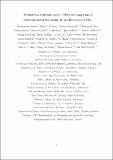Ultrafast triggering of insulator-metal transition in two-dimensional VSe2
Date
18/02/2021Author
Grant ID
2016-006
URF/R/180026
EP/L017008/1
Keywords
Metadata
Show full item recordAbstract
The transition-metal dichalcogenide VSe2 exhibits an increased charge density wave transition temperature and an emerging insulating phase when thinned to a single layer. Here, we investigate the interplay of electronic and lattice degrees of freedom that underpin these phases in single-layer VSe2 using ultrafast pump–probe photoemission spectroscopy. In the insulating state, we observe a light-induced closure of the energy gap, which we disentangle from the ensuing hot carrier dynamics by fitting a model spectral function to the time-dependent photoemission intensity. This procedure leads to an estimated time scale of 480 fs for the closure of the gap, which suggests that the phase transition in single-layer VSe2 is driven by electron–lattice interactions rather than by Mott-like electronic effects. The ultrafast optical switching of these interactions in SL VSe2 demonstrates the potential for controlling phase transitions in 2D materials with light.
Citation
Biswas , D , Jones , A J H , Majchrzak , P , Choi , B K , Lee , T-H , Volckaert , K , Feng , J , Marković , I , Andreatta , F , Kang , C-J , Kim , H J , Lee , I H , Jozwiak , C , Rotenberg , E , Bostwick , A , Sanders , C E , Zhang , Y , Karras , G , Chapman , R T , Wyatt , A S , Springate , E , Miwa , J A , Hofmann , P , King , P D C , Chang , Y J , Lanatà , N & Ulstrup , S 2021 , ' Ultrafast triggering of insulator-metal transition in two-dimensional VSe 2 ' , Nano Letters , vol. Articles ASAP . https://doi.org/10.1021/acs.nanolett.0c04409
Publication
Nano Letters
Status
Peer reviewed
ISSN
1530-6984Type
Journal article
Description
Funding: VILLUM FONDEN through the Young Investigator Program (Grant. No. 15375) and the Centre of Excellence for Dirac Materials (Grant. No. 11744), the Danish Council for Independent Research, Natural Sciences under the Sapere Aude program (Grant Nos. DFF-9064-00057B and DFF-6108-00409) and the Aarhus University Research Foundation. This work is also supported by National Research Foundation (NRF) grants funded by the Korean government (nos. NRF-2020R1A2C200373211 and 2019K1A3A7A09033389) and by the International Max PlanckResearch School for Chemistry and Physics of Quantum Materials (IMPRS-CPQM). The authors also acknowledge The Royal Society and The Leverhulme Trust.Collections
Items in the St Andrews Research Repository are protected by copyright, with all rights reserved, unless otherwise indicated.

